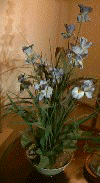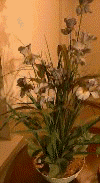

Flowers in daylight (SoLux) and incandescent
Daylight Education Page


Flowers in daylight (SoLux)
and incandescent
What brings out the true colors in a flower, a piece of
jewelry, clothing, painting? The answer lies with the same reason
everything looks better on a clear sunny day. Daylight, with its
full rainbow of colors is the best light source for viewing
colors.
Mentally step into a darkened room. What is the color of the
floor?.... Black. Ceiling?.... Black. Without light, there is no
color and the type of light used to illuminate a room directly
affects how we perceive color. Use a red flashlight and check out
the colors in the darkened room. Obviously everything would look
red. The same principle applies to other sources. Incandescent
light makes a room appear warm, fluorescent light makes objects
look pale and flat, and daylight makes everything look true and
natural.
Since beginning of time daylight has only been available with the
rising of the sun and disappears when the sun sets. In addition,
daylight has been associated with ultraviolet (UV) and infrared
radiation (IR). With the advent SoLux
daylight is now available twenty-four hours a day, indoors where
it is most needed, and without the UV and IR.
Daylight is defined as the combination of sunlight and skylight.
The daylight condition most commonly associated with a clear blue
cloudless day exists at about 6000K. Rarely, if ever, will you
hear someone walk out into these conditions and say, "Today
is too cool"or "too blue". However, if you take
these same lighting conditions and view them in an indoor setting
your perception will be that the same light you thought was
"natural"outdoors now surprisingly appears bluish. The
paper "Daylight is it in the eye of the
Beholder?" explains the physiological and environmental
reasons
for this phenomena and ways to overcome it.